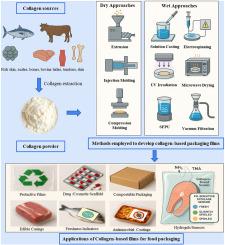Development and innovations in collagen-based packaging for enhancing food safety and shelf life
IF 15.4
1区 农林科学
Q1 FOOD SCIENCE & TECHNOLOGY
引用次数: 0
Abstract
Background
The substantial environmental issues associated with synthetic polymer-based food packaging have intensified the exploration of eco-friendly, biodegradable alternatives. Collagen has emerged as an efficient alternative due to its excellent film-forming capacity, biodegradability, biocompatibility, and potential to incorporate functional additives for food preservation. However, a comprehensive understanding of its extraction, processing techniques, and real-time applicability in food packaging is still fragmented.
Scope and approach
This is the first study to address the fragmented understanding of collagen-based food packaging by conducting a PRISMA 2020-compliant systematic review to synthesize current knowledge on collagen sources (fish, bovine, and other animal by-products), extraction methods (acid and enzyme-assisted collagen extraction), and film fabrication methods (wet and dry approaches). It further explored applications of collagen films to enhance the shelf life and freshness monitoring of real food systems.
Key findings and conclusion
This systematic review reveals that collagen is primarily extracted from fish and bovine sources via acid-soluble methods. Solution casting method dominates laboratory-scale fabrication of collagen films, while electrospinning enables plasticizer-free nanofibrous structures with enhanced surface area and mechanical properties. Whereas underutilized dry processing techniques (extrusion and compression molding) offer scalable, solvent-free alternatives. Moreover, blending collagen with polysaccharides or reinforcing with nanomaterials improves barrier and mechanical performance, and functionalization with antimicrobials, antioxidants, or pH-sensitive plant extracts enables active and smart packaging for extending food shelf life and freshness monitoring. These findings underscore collagens’ strong potential as a sustainable, multifunctional alternative to conventional plastic packaging, particularly when integrated with scalable processing and responsive functionalities.

开发和创新胶原蛋白为基础的包装,以提高食品安全和保质期
与合成聚合物为基础的食品包装相关的大量环境问题已经加强了对生态友好,可生物降解替代品的探索。胶原蛋白因其优异的成膜能力、可生物降解性、生物相容性以及加入功能性添加剂用于食品保存的潜力而成为一种有效的替代品。然而,对其提取、加工技术和在食品包装中的实时适用性的全面了解仍然是碎片化的。这是第一个通过对胶原蛋白来源(鱼、牛和其他动物副产品)、提取方法(酸和酶辅助胶原蛋白提取)和膜制作方法(湿法和干法)的现有知识进行符合PRISMA 2020标准的系统综述来解决对胶原蛋白食品包装的碎片化理解的研究。它进一步探索了胶原蛋白薄膜在提高实际食品系统的保质期和新鲜度监测方面的应用。本系统综述表明,胶原蛋白主要通过酸溶法从鱼类和牛源中提取。溶液浇铸法在实验室规模的胶原蛋白薄膜制造中占主导地位,而静电纺丝可以使无增塑剂的纳米纤维结构具有增强的表面积和机械性能。而未充分利用的干法加工技术(挤压和压缩成型)提供了可扩展的,无溶剂的替代品。此外,将胶原蛋白与多糖混合或用纳米材料增强可改善屏障和机械性能,并与抗菌剂、抗氧化剂或ph敏感植物提取物进行功能化,从而实现活性和智能包装,延长食品保质期和新鲜度监测。这些发现强调了胶原蛋白作为一种可持续的、多功能的传统塑料包装替代品的巨大潜力,特别是当它与可扩展的加工和响应功能相结合时。
本文章由计算机程序翻译,如有差异,请以英文原文为准。
求助全文
约1分钟内获得全文
求助全文
来源期刊

Trends in Food Science & Technology
工程技术-食品科技
CiteScore
32.50
自引率
2.60%
发文量
322
审稿时长
37 days
期刊介绍:
Trends in Food Science & Technology is a prestigious international journal that specializes in peer-reviewed articles covering the latest advancements in technology, food science, and human nutrition. It serves as a bridge between specialized primary journals and general trade magazines, providing readable and scientifically rigorous reviews and commentaries on current research developments and their potential applications in the food industry.
Unlike traditional journals, Trends in Food Science & Technology does not publish original research papers. Instead, it focuses on critical and comprehensive reviews to offer valuable insights for professionals in the field. By bringing together cutting-edge research and industry applications, this journal plays a vital role in disseminating knowledge and facilitating advancements in the food science and technology sector.
 求助内容:
求助内容: 应助结果提醒方式:
应助结果提醒方式:


